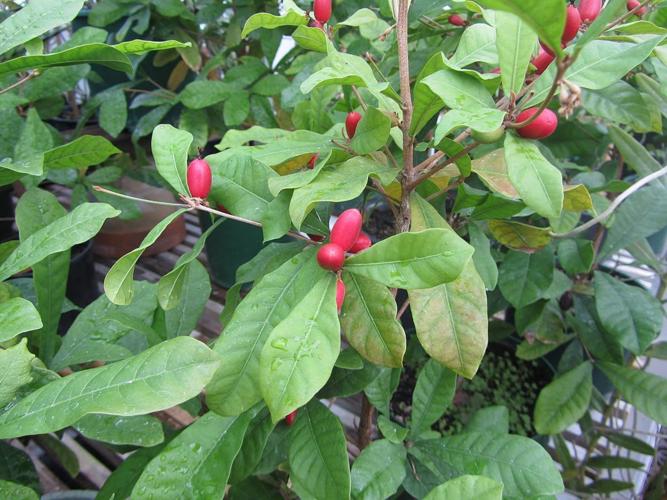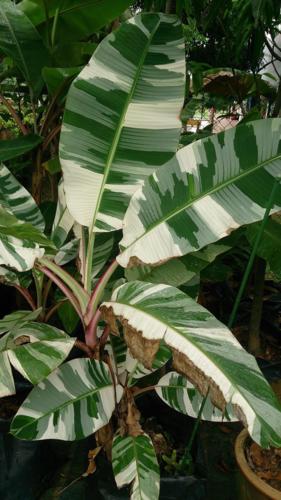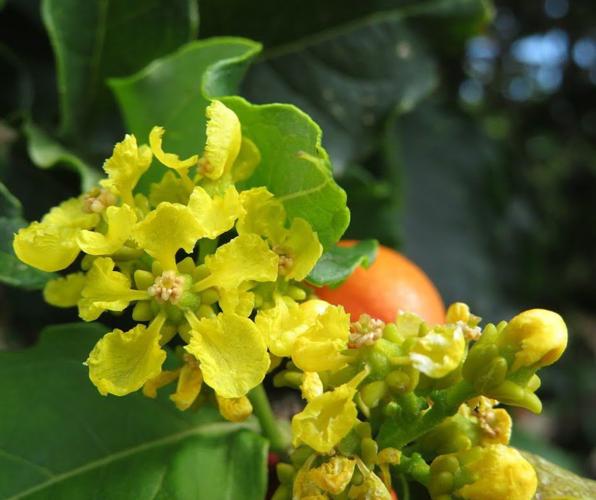February 3, 2021 by Kraken
Wish List Plants: Kraken’s Top 9
Let’s pretend I live in an area where I don’t have to survive off reindeer meat and moose milk eight months out of the year (zone 4b) and I could grow things that actually taste good (looking at you aronia berries) in my region. Maybe I have a beast of a greenhouse, maybe I just move like six hours South. Whatever, I got land and climate. This is what I would grow:
Miracle berries (Synsepalum dulcificum)
I tried these once that were sent to me from a buddy who lives in Florida. He told me they grow really well in pots and should be grown that way. Much like blueberries, they require acidic soil. I’ve been tempted to grow them myself since they might make a compact shrub I can move inside. For those that don’t know, miracle berry changes your taste buds with a chemical called miraculin. It changes sour things sweet. This is really cool if you want to make something sweet without adding sugar or show your guest how bad your mental health has deteriorated in the face of current events by casually eating limes like an apple while sitting on your couch. No one will mess with you, I guarantee it.

Pineapple guava (Acca sellowiana)
This is one I found when I was looking for hardy tropical plants (do those even exist?) so I could possibly keep them in my garage or something during the winter. This tree survives down to 12° Fahrenheit and has flowers that I’ve been told taste like cotton candy or root beer. The fruit that develops has a flavor reminiscent of fruit punch. This is another one that can grow well in a pot.
Pisang Keling (Musa × paradisiaca), ‘Gros Michel’ (Musa acuminata) and ‘Ae Ae’ banana (Musa sp.)
I want these specifically just because I’ve always felt like Americans got snubbed on bananas (and mangoes, but that’s another story) and we don’t get a lot of good ones. Pisang Keling is a popular banana in Malaysia that apparently, as explained by Weird Explorer on YouTube, tastes like strawberry shortcake. It has a very desert-like flavor to it. Gros Michel is in the same vein, having apparently a candy flavor to it. It is said that banana Runts candies were modeled after its flavor. The Ae Ae banana grows larger bananas than your standard Cavendish supermarket banana and has a better taste, the variegated leaves scream house plant too, with splotches and lines running up it, giving it an almost pixelated appearance. If you are growing topical stuff, you might as well flex with the natural beauty of the tropics.

Cloudberries (Rubus chamaemorus)
Finally, one that can actually grow where I live. Native to Scandinavia, it is known for being really hard to find any seeds for planting while paradoxically being a fruit that most berry searchers I know have been able to successfully find in the wild. The berries fetch a high price tag in gourmet restaurants even though you can apparently find them at farmers markets for a pretty affordable price (according to my Scandinavian relatives). I might have to just have them send me some so I can try them for myself.
Oyster leaf (Mertensia maritima)
This Is a plant that is notoriously hard to grow. Also notoriously, the leaves taste like oysters. As meat prices where I live have gone up, I have started turning to plant-based alternatives I can grow to give a dish a meat-like flavor without having to drop a considerable portion of my grocery budget on meat. Seriously, it’s ridiculous at times.

Paw paw (Asimina triloba)
A fruit that amazingly grows where I live. Barely, but it grows here. It has a really tropical flavor similar to bananas or mangoes. Much like a cherimoya, you have to eat the fruit when it’s just right or it has a strange soapy taste, in my opinion. Its leaves can be used as a pesticide as well and the plant can be used as an under-story tree in a food forest.
Peanut butter fruit (Bunchosia argentea or armeniaca, sources differ)
This one is more for my mom who is really allergic to peanuts. It would be great to have a plant that produces fruits I can use as a peanut butter alternative. It’s unfortunately too tropical for me to grow. Maybe one day I will have enough room and light to do it.

Lemon drop mangosteen (Garcinia intermedia)
Another tree that’s too tropical for me to try at this time. I’ve heard multiple people describe this as the best fruit on earth. It has a sweet and sour flavor that is difficult to compare to other fruits. Purple mangosteens are often called the “queen of fruits” and this relative has an even more intense flavor.
‘Sugar Dragon’ and ‘Voodoo Child’ dragon fruit (Hylocereus)
The thing with dragon fruit is it doesnt require a lot of maintenance at all. They can fruit in a wide range of conditions and can take stress very well, which is why I recommend people in my region grow it. The specific cultivars ‘Sugar Dragon’ and ‘Voodoo Child’ I want due to their fast growth. They mature early and quickly as smaller plants overall. This is great because when you only have, at absolute max, 7 months to grow these things outdoors, a fast growing small dragon fruit is ideal. The research doesn’t seem to be out on how large the plant has to be before it’s mature and will start flowering but I know for some larger varieties mature plants weigh in at around 10 pounds. I’m not sure if this means it’s ten pounds of Hylocereus per fruit it produces or once the plant is around ten pounds in mass it will start producing fruit; regardless that’s a lot of mass for a vine. If you are lucky, once the vine has matured, with ‘Voodoo Child’ and ‘Sugar Dragon’, you can get two, maybe even three harvests in a season. You can also extend your growing season (and give the plant a better chance at that extra harvest) if you offer it some light frost protection in the early spring and fall.